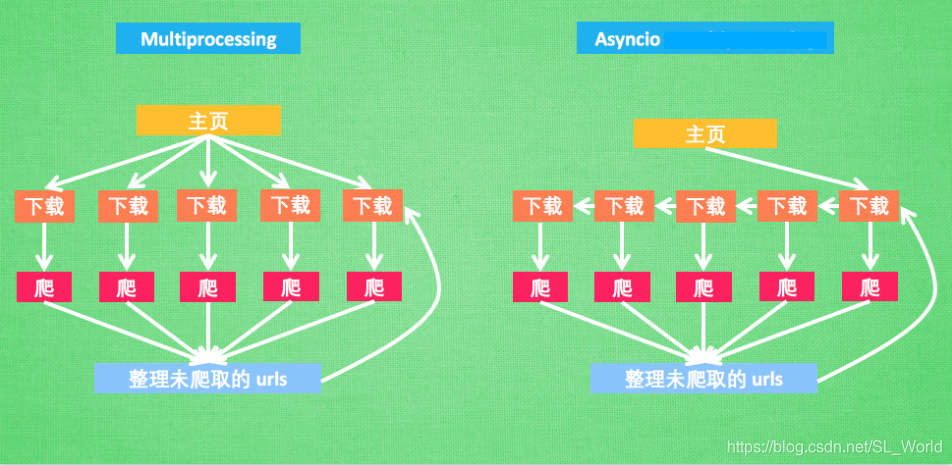Python实战异步爬虫(协程)+分布式爬虫(多进程) |
您所在的位置:网站首页 › python多线程协程 › Python实战异步爬虫(协程)+分布式爬虫(多进程) |
Python实战异步爬虫(协程)+分布式爬虫(多进程)
|
引言:我们在写爬虫时常会遇到这样的问题,当需要爬取多个URL时,写一个普通的基于requests库的爬虫程序爬取时间会很长。因为是顺序请求网页的,而网页请求和获得响应过程比较耗费时间,程序不得不等待获得当前网页响应后才能进行下一个URL的爬取,使得总耗时较多。对于这样的多任务,可以使用基于多进程(multiprocessing)和基于Asyncio库的异步(协程)爬虫增强并发性,加速爬虫。 Talk is cheap,show me the picture!在讲解之前,我们先来通过一幅图看清多进程和协程的爬虫之间的原理及其区别。(图片来源于网络) 在有了Asyncio异步IO库实现协程后,我们还需要实现异步网页请求。因此,aiohttp库应运而生。 使用aiohttp库实现异步网页请求在我们写普通的爬虫程序时,经常会用到requests库用以请求网页并获得服务器响应。而在协程中,由于requests库提供的相关方法不是可等待对象(awaitable),使得无法放在await后面,因此无法使用requests库在协程程序中实现请求。 在此,官方专门提供了一个aiohttp库,用来实现异步网页请求等功能,简直就是异步版的requests库,当然需要我们手动安装该库(如下所示)。 >>> pip3 install aiohttp【基础实现】:在官方文档中,推荐使用ClientSession()函数来调用网页请求等相关方法。 首先,我们需要引入aiohttp模块。 import aiohttp然后,我们在协程中使用ClientSession()的get()或request()方法来请求网页。(其中async with是异步上下文管理器,其封装了异步实现等功能) async with aiohttp.ClientSession() as session: async with session.get('http://httpbin.org/get') as resp: print(resp.status) print(await resp.text())ClientSession()除了有请求网页的方法,官方API还提供了其他HTTP常见方法。 session.request(method='GET', url='http://httpbin.org/request') session.post('http://httpbin.org/post', data=b'data') session.put('http://httpbin.org/put', data=b'data') session.delete('http://httpbin.org/delete') session.head('http://httpbin.org/get') session.options('http://httpbin.org/get') session.patch('http://httpbin.org/patch', data=b'data')如欲看完整的aiohttp使用方法,请见官方文档。 【案例】【任务】:爬取2018年AAAI顶会中10篇论文的标题。 下面是一个普通的同步代码,实现顺序爬取10个URL的title。 import time from lxml import etree import requests urls = [ 'https://aaai.org/ocs/index.php/AAAI/AAAI18/paper/viewPaper/16488', 'https://aaai.org/ocs/index.php/AAAI/AAAI18/paper/viewPaper/16583', # 省略后面8个url... ] ''' 提交请求获取AAAI网页,并解析HTML获取title ''' def get_title(url,cnt): response = requests.get(url) # 提交请求,获取响应内容 html = response.content # 获取网页内容(content返回的是bytes型数据,text()获取的是Unicode型数据) title = etree.HTML(html).xpath('//*[@id="title"]/text()') # 由xpath解析HTML print('第%d个title:%s' % (cnt,''.join(title))) if __name__ == '__main__': start1 = time.time() i = 0 for url in urls: i = i + 1 start = time.time() get_title(url,i) print('第%d个title爬取耗时:%.5f秒' % (i,float(time.time() - start))) print('爬取总耗时:%.5f秒' % float(time.time()-start1))执行结果如下: 第1个title:Norm Conflict Resolution in Stochastic Domains 第1个title爬取耗时:1.41810秒 第2个title:Algorithms for Trip-Vehicle Assignment in Ride-Sharing 第2个title爬取耗时:1.31734秒 第3个title:Tensorized Projection for High-Dimensional Binary Embedding 第3个title爬取耗时:1.31826秒 第4个title:Synthesis of Programs from Multimodal Datasets 第4个title爬取耗时:1.28625秒 第5个title:Video Summarization via Semantic Attended Networks 第5个title爬取耗时:1.33226秒 第6个title:TIMERS: Error-Bounded SVD Restart on Dynamic Networks 第6个title爬取耗时:1.52718秒 第7个title:Memory Management With Explicit Time in Resource-Bounded Agents 第7个title爬取耗时:1.35522秒 第8个title:Mitigating Overexposure in Viral Marketing 第8个title爬取耗时:1.35722秒 第9个title:Neural Link Prediction over Aligned Networks 第9个title爬取耗时:1.51317秒 第10个title:Dual Deep Neural Networks Cross-Modal Hashing 第10个title爬取耗时:1.30624秒 爬取总耗时:13.73324秒可见,平均每请求完一个URL并解析该HTML耗时1.4秒左右。本次程序运行总耗时13.7秒。 二、测试基于协程的异步爬虫程序下面,是使用了协程的异步爬虫程序。etree模块用于解析HTML,aiohttp是一个利用asyncio的库,它的API看起来很像请求的API,可以暂时看成协程版的requests。 import time from lxml import etree import aiohttp import asyncio urls = [ 'https://aaai.org/ocs/index.php/AAAI/AAAI18/paper/viewPaper/16488', 'https://aaai.org/ocs/index.php/AAAI/AAAI18/paper/viewPaper/16583', # 省略后面8个url... ] titles = [] sem = asyncio.Semaphore(10) # 信号量,控制协程数,防止爬的过快 ''' 提交请求获取AAAI网页,并解析HTML获取title ''' async def get_title(url): with(await sem): # async with是异步上下文管理器 async with aiohttp.ClientSession() as session: # 获取session async with session.request('GET', url) as resp: # 提出请求 # html_unicode = await resp.text() # html = bytes(bytearray(html_unicode, encoding='utf-8')) html = await resp.read() # 可直接获取bytes title = etree.HTML(html).xpath('//*[@id="title"]/text()') print(''.join(title)) ''' 调用方 ''' def main(): loop = asyncio.get_event_loop() # 获取事件循环 tasks = [get_title(url) for url in urls] # 把所有任务放到一个列表中 loop.run_until_complete(asyncio.wait(tasks)) # 激活协程 loop.close() # 关闭事件循环 if __name__ == '__main__': start = time.time() main() # 调用方 print('总耗时:%.5f秒' % float(time.time()-start))执行结果如下: Memory Management With Explicit Time in Resource-Bounded Agents Norm Conflict Resolution in Stochastic Domains Video Summarization via Semantic Attended Networks Tensorized Projection for High-Dimensional Binary Embedding Algorithms for Trip-Vehicle Assignment in Ride-Sharing Dual Deep Neural Networks Cross-Modal Hashing Neural Link Prediction over Aligned Networks Mitigating Overexposure in Viral Marketing TIMERS: Error-Bounded SVD Restart on Dynamic Networks Synthesis of Programs from Multimodal Datasets 总耗时:2.43371秒可见,本次我们使用协程爬取10个URL只耗费了2.4秒,效率是普通同步程序的8~12倍。 【解释】: request获取的text()返回的是网页的Unicode型数据,content和read()返回的是bytes型数据。而etree.HTML(html)接收的参数需是bytes类型,所以①可以通过resp.read()直接获取bytes;②若使用text()则需要通过先把Unicode类型数据转换成比特数组对象,再转换成比特对象, 即bytes(bytearray(html_unicode, encoding='utf-8'))。发起请求除了可以用上述session.request('GET', url)也可以用session.get(url),功能相同。如果同时做太多的请求,链接有可能会断掉。所以需要使用sem = asyncio.Semaphore(10) ,Semaphore是限制同时工作的协同程序数量的同步工具。async with是异步上下文管理器,不解的请看Python中的async with用法。 三、测试基于多进程的分布式爬虫程序下面,我们测试多进程爬虫程序,由于我的电脑CPU是4核,所以这里进程池我就设的4。 import multiprocessing from multiprocessing import Pool import time import requests from lxml import etree urls = [ 'https://aaai.org/ocs/index.php/AAAI/AAAI18/paper/viewPaper/16488', 'https://aaai.org/ocs/index.php/AAAI/AAAI18/paper/viewPaper/16583', # 省略后面8个url... ] ''' 提交请求获取AAAI网页,并解析HTML获取title ''' def get_title(url,cnt): response = requests.get(url) # 提交请求 html = response.content # 获取网页内容 title = etree.HTML(html).xpath('//*[@id="title"]/text()') # 由xpath解析HTML print('第%d个title:%s' % (cnt,''.join(title))) ''' 调用方 ''' def main(): print('当前环境CPU核数是:%d核' % multiprocessing.cpu_count()) p = Pool(4) # 进程池 i = 0 for url in urls: i += 1 p.apply_async(get_title, args=(url, i)) p.close() p.join() # 运行完所有子进程才能顺序运行后续程序 if __name__ == '__main__': start = time.time() main() # 调用方 print('总耗时:%.5f秒' % float(time.time()-start))执行结果: 当前环境CPU核数是:4核 第2个title:Algorithms for Trip-Vehicle Assignment in Ride-Sharing 第1个title:Norm Conflict Resolution in Stochastic Domains 第4个title:Synthesis of Programs from Multimodal Datasets 第3个title:Tensorized Projection for High-Dimensional Binary Embedding 第5个title:Video Summarization via Semantic Attended Networks 第6个title:TIMERS: Error-Bounded SVD Restart on Dynamic Networks 第7个title:Memory Management With Explicit Time in Resource-Bounded Agents 第8个title:Mitigating Overexposure in Viral Marketing 第9个title:Neural Link Prediction over Aligned Networks 第10个title:Dual Deep Neural Networks Cross-Modal Hashing 总耗时:5.01228秒可见,多进程分布式爬虫也比普通同步程序要快很多,本次运行时间5秒。但比协程略慢。 【时间对比】: 对于上例中10个URL的爬取时间,下面整理成了表格。 CPU核数\实现方式普通同步爬虫多进程爬虫异步爬虫4核13.7秒5.0秒2.4秒其中增加多进程中进程池Pool(n)的n可加速爬虫,下图显示了消耗的时间(单位.秒)和Pool()参数的关系。 由于解析HTML也需要消耗一定的时间,而aiohttp和asyncio均未提供相关解析方法。所以可以在请求网页的时使用异步程序,在解析HTML使用多进程,两者配合使用,效率更高哦~! 【请求网页】:使用协程。 【解析HTML】:使用多进程。 from multiprocessing import Pool import time from lxml import etree import aiohttp import asyncio urls = [ 'https://aaai.org/ocs/index.php/AAAI/AAAI18/paper/viewPaper/16488', 'https://aaai.org/ocs/index.php/AAAI/AAAI18/paper/viewPaper/16583', # 省略后面8个url... ] htmls = [] titles = [] sem = asyncio.Semaphore(10) # 信号量,控制协程数,防止爬的过快 ''' 提交请求获取AAAI网页html ''' async def get_html(url): with(await sem): # async with是异步上下文管理器 async with aiohttp.ClientSession() as session: # 获取session async with session.request('GET', url) as resp: # 提出请求 html = await resp.read() # 直接获取到bytes htmls.append(html) print('异步获取%s下的html.' % url) ''' 协程调用方,请求网页 ''' def main_get_html(): loop = asyncio.get_event_loop() # 获取事件循环 tasks = [get_html(url) for url in urls] # 把所有任务放到一个列表中 loop.run_until_complete(asyncio.wait(tasks)) # 激活协程 loop.close() # 关闭事件循环 ''' 使用多进程解析html ''' def multi_parse_html(html,cnt): title = etree.HTML(html).xpath('//*[@id="title"]/text()') titles.append(''.join(title)) print('第%d个html完成解析-title:%s' % (cnt,''.join(title))) ''' 多进程调用总函数,解析html ''' def main_parse_html(): p = Pool(4) i = 0 for html in htmls: i += 1 p.apply_async(multi_parse_html,args=(html,i)) p.close() p.join() if __name__ == '__main__': start = time.time() main_get_html() # 调用方 main_parse_html() # 解析html print('总耗时:%.5f秒' % float(time.time()-start))执行结果如下: 异步获取https://aaai.org/ocs/index.php/AAAI/AAAI18/paper/viewPaper/16380下的html. 异步获取https://aaai.org/ocs/index.php/AAAI/AAAI18/paper/viewPaper/16674下的html. 异步获取https://aaai.org/ocs/index.php/AAAI/AAAI18/paper/viewPaper/16583下的html. 异步获取https://aaai.org/ocs/index.php/AAAI/AAAI18/paper/viewPaper/16911下的html. 异步获取https://aaai.org/ocs/index.php/AAAI/AAAI18/paper/viewPaper/17343下的html. 异步获取https://aaai.org/ocs/index.php/AAAI/AAAI18/paper/viewPaper/16449下的html. 异步获取https://aaai.org/ocs/index.php/AAAI/AAAI18/paper/viewPaper/16488下的html. 异步获取https://aaai.org/ocs/index.php/AAAI/AAAI18/paper/viewPaper/16659下的html. 异步获取https://aaai.org/ocs/index.php/AAAI/AAAI18/paper/viewPaper/16581下的html. 异步获取https://aaai.org/ocs/index.php/AAAI/AAAI18/paper/viewPaper/16112下的html. 第3个html完成解析-title:Algorithms for Trip-Vehicle Assignment in Ride-Sharing 第1个html完成解析-title:Tensorized Projection for High-Dimensional Binary Embedding 第2个html完成解析-title:TIMERS: Error-Bounded SVD Restart on Dynamic Networks 第4个html完成解析-title:Synthesis of Programs from Multimodal Datasets 第6个html完成解析-title:Dual Deep Neural Networks Cross-Modal Hashing 第7个html完成解析-title:Norm Conflict Resolution in Stochastic Domains 第8个html完成解析-title:Neural Link Prediction over Aligned Networks 第5个html完成解析-title:Mitigating Overexposure in Viral Marketing 第9个html完成解析-title:Video Summarization via Semantic Attended Networks 第10个html完成解析-title:Memory Management With Explicit Time in Resource-Bounded Agents【参考文献】: [1] aiohttp官方API文档 [2] 加速爬虫: 异步加载 Asyncio [3] python:利用asyncio进行快速抓取 [4] 使用 aiohttp 和 asyncio 进行异步请求 [5] requests的content与text导致lxml的解析问题 |
【本文地址】
今日新闻 |
推荐新闻 |
 这里,异步爬虫不同于多进程爬虫,它使用单线程(即仅创建一个事件循环,然后把所有任务添加到事件循环中)就能并发处理多任务。在轮询到某个任务后,当遇到耗时操作(如请求URL)时,挂起该任务并进行下一个任务,当之前被挂起的任务更新了状态(如获得了网页响应),则被唤醒,程序继续从上次挂起的地方运行下去。极大的减少了中间不必要的等待时间。
这里,异步爬虫不同于多进程爬虫,它使用单线程(即仅创建一个事件循环,然后把所有任务添加到事件循环中)就能并发处理多任务。在轮询到某个任务后,当遇到耗时操作(如请求URL)时,挂起该任务并进行下一个任务,当之前被挂起的任务更新了状态(如获得了网页响应),则被唤醒,程序继续从上次挂起的地方运行下去。极大的减少了中间不必要的等待时间。 【已知】:10个论文页面URL。如欲提前看所有代码请见:GitHub
【已知】:10个论文页面URL。如欲提前看所有代码请见:GitHub 如果你以为到这里就结束了,那你就要错过最精彩的东西了:)
如果你以为到这里就结束了,那你就要错过最精彩的东西了:)